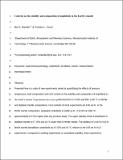Controls on the stability and composition of amphibole in the Earth’s mantle
Author(s)
Mandler, Ben; Grove, Timothy L.
Download410_2016_1281_ReferencePDF.pdf (2.427Mb)
OPEN_ACCESS_POLICY
Open Access Policy
Creative Commons Attribution-Noncommercial-Share Alike
Terms of use
Metadata
Show full item recordAbstract
Presented here is a suite of new experiments aimed at quantifying the effects of pressure, temperature, bulk composition, and H[subscript 2]O content on the stability and composition of amphibole in the Earth’s mantle. Experiments have been performed from 2 to 4 GPa and 950 to 1100 °C on fertile and depleted mantle compositions. H[subscript 2]O contents of most experiments are 0.65 wt%. In the fertile mantle composition, pargasitic amphibole is stable up to ~3.8 GPa at 1000 °C, approximately 0.5 GPa higher than any previous study. The upper stability limit of amphibole in depleted mantle is 0.7 GPa and 40 °C lower than in fertile mantle. The addition of 3 wt% H[subscript 2]O to fertile mantle destabilizes amphibole by 0.5 GPa and 40 °C relative to the 0.65 wt% H[subscript 2]O experiments. Compared to existing experiments on amphibole stability, these experiments indicate that pargasitic amphibole may be stable in mantle lithosphere to almost 4 GPa (0.5 GPa higher (15 km deeper) than previously thought). The extremely strong destabilizing effect of H[subscript 2]O suggests that deeper portions of the strongly fluid-fluxed mantle wedge may be amphibole-free even at low temperatures near the slab–wedge interface. The molar alkali content of amphibole is shown to be a linear function (R[superscript 2] = 0.98) of pressure and temperature and is relatively insensitive to bulk compositional differences between fertile and depleted mantle. This relationship is used to produce an empirical thermobarometer for pargasite-bearing spinel and garnet lherzolites. Comparison to existing experimental data shows that this thermobarometer has predictive ability over the pressure range of 1–4 GPa. Comparisons with pressure–temperature estimates of garnet + amphibole peridotites further corroborate the applicability of this thermobarometer for natural samples. Pressure estimates are presented for four examples of metasomatized spinel peridotites otherwise lacking pressure information, and future avenues for refinement of the thermobarometer are discussed.
Date issued
2016-08Department
Massachusetts Institute of Technology. Department of Earth, Atmospheric, and Planetary SciencesJournal
Contributions to Mineralogy and Petrology
Publisher
Springer Berlin Heidelberg
Citation
Mandler, Ben E., and Timothy L. Grove. “Controls on the Stability and Composition of Amphibole in the Earth’s Mantle.” Contributions to Mineralogy and Petrology 171.8–9 (2016): n. pag.
Version: Author's final manuscript
ISSN
0010-7999
1432-0967